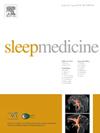超越婴儿绞痛:跟踪运动技能,感觉处理和睡眠在幼儿期的尖端
IF 3.4
2区 医学
Q1 CLINICAL NEUROLOGY
引用次数: 0
摘要
本研究旨在评估有婴儿绞痛史的幼儿的运动发育、感觉处理技能和睡眠特征,并将其与正常发育的同龄人进行比较。共有46名幼儿参与了这项研究:24名有婴儿绞痛史的幼儿和22名发育正常的同龄人(对照组),年龄在10到15个月之间。分别使用婴儿感觉功能测试、皮博迪运动发育量表- 2和婴儿简短睡眠问卷对感觉加工技能、运动发育和睡眠特征进行评估。对照组在触觉深压反应性(p = 0.026)、自适应运动功能(p = 0.003)、视触觉整合(p = 0.012)和总分(p <;0.001),对照组大肌肉运动得分更高(p <;0.001),精细运动(p = 0.025)和运动总分(p <;0.001),由PDMS-2测量。在检查各组的睡眠特征时,对照组的夜间睡眠时间(p = 0.039)和总睡眠时间(p = 0.009)明显更长。绞痛组夜间醒来频率显著增高(p = 0.004),夜间清醒频率显著增高(p = 0.006)。与同龄人相比,有婴儿绞痛史的幼儿在睡眠模式、感觉处理和运动发育方面遇到更大的困难。早期评估和有针对性的干预方案对于解决这些潜在的发育迟缓至关重要。本文章由计算机程序翻译,如有差异,请以英文原文为准。

Beyond infantile colic: tracking motor skills, sensory processing, and sleep at the cusp of toddlerhood
This study aimed to evaluate the motor development, sensory processing skills, and sleep characteristics of toddlers with a history of infantile colic and compare them to their typically developing peers. A total of 46 toddlers were included in the study: 24 toddlers with a history of infantile colic and 22 typically developing peers (control group), aged between 10 and 15 months. Sensory processing skills, motor development, and sleep characteristics were evaluated using the Test of Sensory Functions in Infants, the Peabody Developmental Motor Scales–2, and the Brief Infant Sleep Questionnaire, respectively. Significant differences in favor of the control group were observed in reactivity to tactile deep pressure (p = 0.026), adaptive motor function (p = 0.003), visual-tactile integration (p = 0.012), and total scores (p < 0.001) assessed by the TSFI, as well as in the control group scored higher in gross motor (p < 0.001), fine motor (p = 0.025), and total motor scores (p < 0.001) measured by the PDMS-2. Upon examining the sleep characteristics of the groups, nighttime sleep duration (p = 0.039) and total sleep duration (p = 0.009) were significantly longer in the control group. The colic group exhibited a significantly higher frequency of nocturnal awakenings (p = 0.004) and greater nocturnal wakefulness (p = 0.006). Toddlers with a history of infantile colic experience greater difficulties in sleep patterns, sensory processing, and motor development compared to their peers. Early evaluation and targeted intervention programs are crucial for addressing these potential developmental delays.
求助全文
通过发布文献求助,成功后即可免费获取论文全文。
去求助
来源期刊

Sleep medicine
医学-临床神经学
CiteScore
8.40
自引率
6.20%
发文量
1060
审稿时长
49 days
期刊介绍:
Sleep Medicine aims to be a journal no one involved in clinical sleep medicine can do without.
A journal primarily focussing on the human aspects of sleep, integrating the various disciplines that are involved in sleep medicine: neurology, clinical neurophysiology, internal medicine (particularly pulmonology and cardiology), psychology, psychiatry, sleep technology, pediatrics, neurosurgery, otorhinolaryngology, and dentistry.
The journal publishes the following types of articles: Reviews (also intended as a way to bridge the gap between basic sleep research and clinical relevance); Original Research Articles; Full-length articles; Brief communications; Controversies; Case reports; Letters to the Editor; Journal search and commentaries; Book reviews; Meeting announcements; Listing of relevant organisations plus web sites.
 求助内容:
求助内容: 应助结果提醒方式:
应助结果提醒方式:


